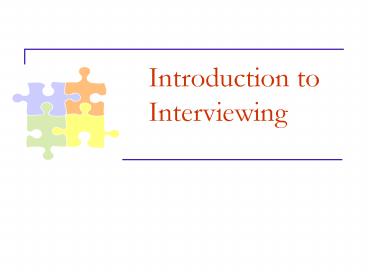Introduction to Interviewing - PowerPoint PPT Presentation
1 / 18
Title:
Introduction to Interviewing
Description:
Is the best way to get verbatim transcripts. Required for discourse-oriented studies. ... Appropriate when verbatim data are not needed. ... – PowerPoint PPT presentation
Number of Views:68
Avg rating:3.0/5.0
Title: Introduction to Interviewing
1
Introduction to Interviewing
- Institute for Financial and Management Research
2
What is an interview?
- An important tool of qualitative research.
- Person-to-person or person-to-group encounter.
- A conversation with a purpose.
- Obtains information on values, meanings,
perspectives, beliefs, and other unobservable
phenomena.
3
Why use interviews?
- The interview is a tool in qualitative research
that allows us to enter into the other persons
perspective. - We cannot observe
- Feelings, thoughts, and intentions
- Behaviors that took place at some previous point
in time - Situations that preclude the presence of an
observer - How people have organized the world and the
meanings they attach to what goes on in the
world. - We have to ask people questions about these
things.
4
When to use interviews?
- Interview should be the primary mode of data
collection when a study seeks to learn about - Perspectives and interpretations of a range of
people. - Past events that cannot be recreated or
replicated. - Case studies and profiles that seek to represent
particular experiences of individuals and small
groups.
5
Types of Interviews
6
Types of interviews I
- In-depth is used widely in qualitative
research. - Ethnographic focused on culture as seen through
the participants eyes, and through a firsthand
encounter. - Phenomenological is about structure and essence
of phenomena. - Elite interviewees have specialized knowledge,
and are sampled for this reason. - Focus Group semi-structured group interview
with focused topic/s.
7
Types of interviews II
- Structured similar to oral survey useful to
gather data on specific issues. - Semi-structured with structured questions on
specific issues and open-ended questions on
issues that need to be explored. - Unstructured for exploratory phases of a study.
Rarely used because they can distract the
researcher from the topic of study.
8
In-depth Interview
- Extensively used method in qualitative research.
- A conversation with a purpose. The researcher
has a general idea of topics to ask about, but
respects how the participant frames and
structures the responses. - The participants perspective on the topic should
unfold as the participant views it, not as the
researcher views it. - Combined with participant observation, interviews
allow the researcher to understand the meanings
people hold for their everyday activities.
9
Focus group discussions
- Originated in marketing research
- Groups composed of 5-10 (this can vary) people
selected because they share certain
characteristics relevant to the study. - Interviewer creates a permissive environment
asks focused questions encourages discussion and
expression. - FGDs are conducted several times with different
groups to map patterns in perception and opinion.
- Careful and systematic analysis of data is a
must.
10
Interview Questions
11
Good questions
- Good questions are clear and make sense to the
interviewee and avoid technical terms and
jargon. - Hypothetical questions. Suppose it is my first
day ?. - Devils advocate questions. Some people would
say? - Ideal position questions. What do you think the
ideal? - Interpretive questions. Would you say?
12
Questions to avoid
- Avoid
- Multiple questions.
- Leading questions.
- Yes-or-No questions.
13
Probes
- Probes are follow-up questions or comments used
for - Clarification
- Details
- Examples
- Probes can take numerous forms
- Silence
- Yes, or uh, huh
- Short questions
- Brief comments
14
The interview guide
- Called a guide or schedule, it is a list of
questions you intend to ask during the interview. - Guide may be highly, semi-, or un-structured,
depending on the nature of the interview. - Structure of the guide depends on the studys
objective, time allotted for interview, the
person being interviewed, and how sensitive some
of the questions are. - Guide should begin with neutral and structured
questions and lead to open-ended, conversational
(sometimes personal) questions.
15
Conducting the Interview
16
Before the interview
- Select respondents based on their potential to
contribute to the development of insight, and
understanding of the phenomenon. - Use early interviews as exploratory exercises
that help identify key informants and interview
sample. - Make your motives and the inquirys purpose
transparent. - Protect respondents identities through use of
pseudonyms. - Decide who has final say over studys content.
- Agree on payment (if any).
- Provide clear details on logistics about time,
place, and number of interviews.
17
Interviewer and respondent interaction
- Success of the interview is determined by
- Personality and skill of the interviewer. Be
respectful, non-judgmental, and non-threatening. - Practice. Get more skilled through role play,
peer critique, videotaping, and observing
experienced researchers. - Attitudes and orientation of the interviewee.
Approach respondents who can express thoughts,
feelings, opinions (perspectives) on the topic of
study. - Definition of the interview situation by both as
safe, productive, important, or the
opposite.
18
Recording and evaluating interview data
- Tape-recording the interview.
- Is the best way to get verbatim transcripts.
- Required for discourse-oriented studies.
- Time and labor intensive. Equipment can
malfunction. - Writing extensive notes during the course of the
interview. - Used widely. Needed as a back-up even when tape
recorded. - Appropriate when verbatim data are not needed.
- Write down as much as possible right after the
interview. - Least desirable method as interpretation and
selective memory will intrude on accuracy of the
data.































